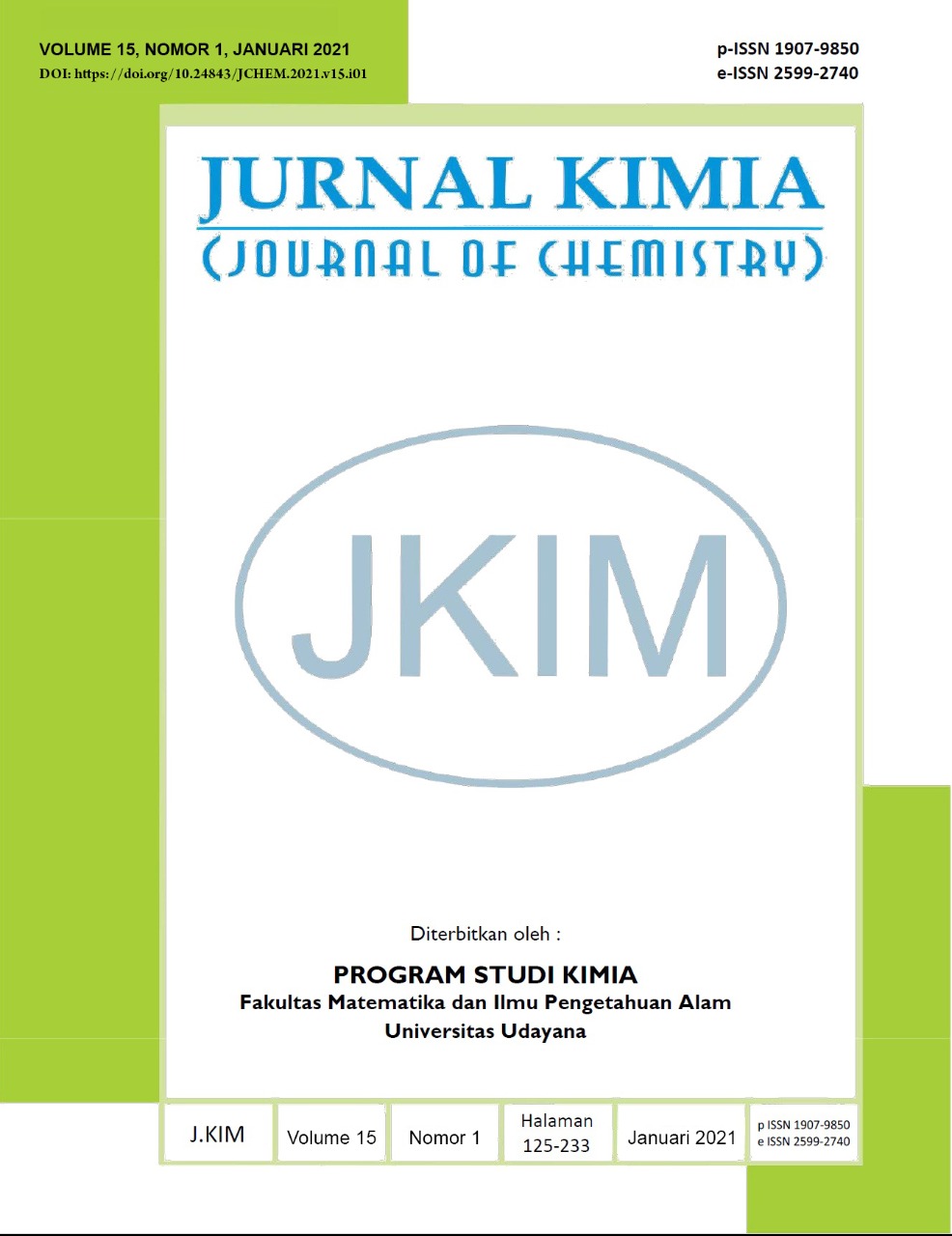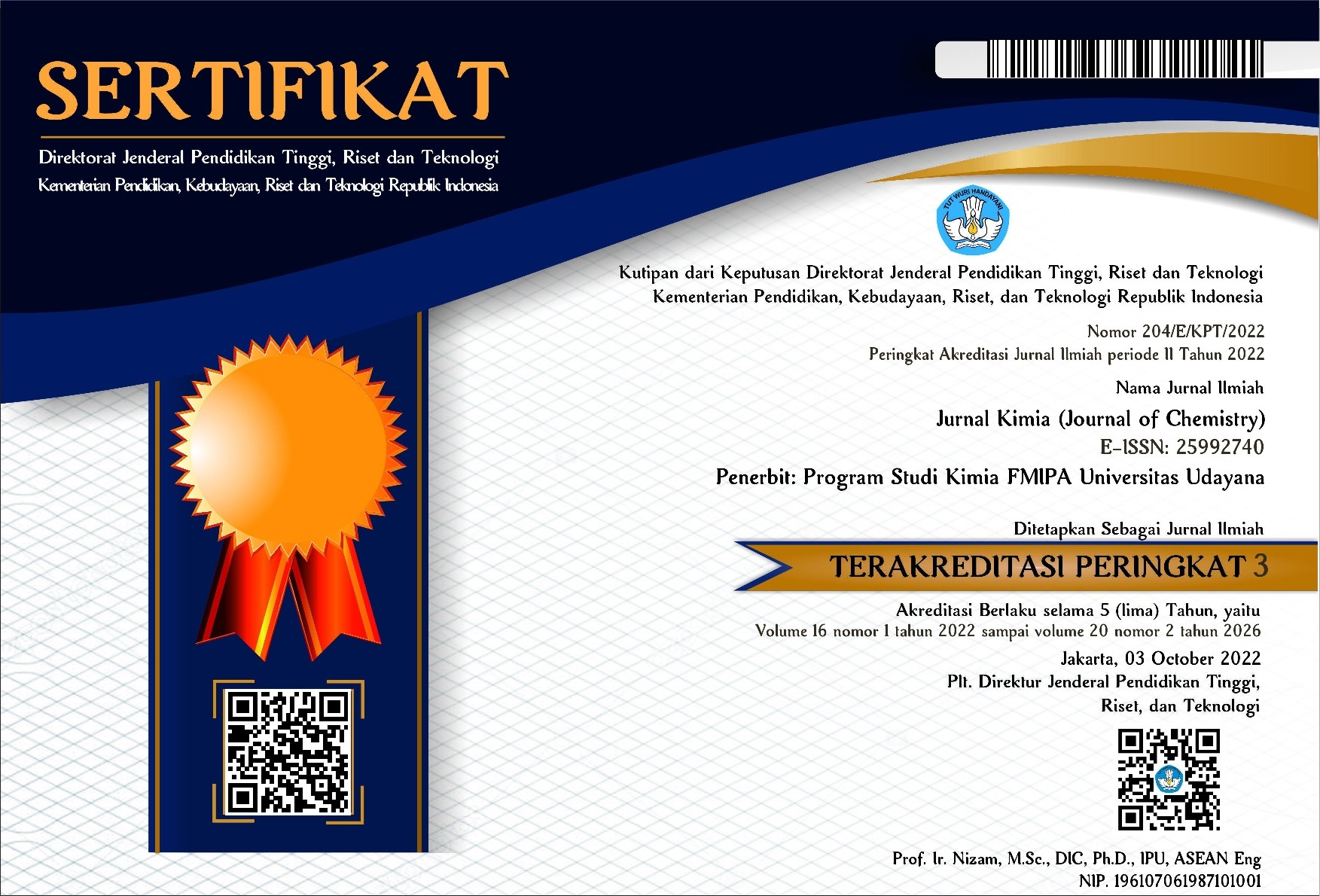PEMURNIAN AMILASE MIKROBA AMILOLITIK DENGAN FRAKSINASI AMONIUM SULFAT DAN AMOBILISASI PADA AGAR-AGAR KOMERSIAL
Abstract
Peningkatan penggunaan biokatalis amilase membutuhkan pemurnian dan amobilisasi enzim ini untuk berbagai keperluan yang lebih ekonomis. Tujuan penelitian ini adalah menentukan persen kejenuhan amonium sulfat untuk pemurnian amilase mikroba amilolitik dan persen konsentrasi agar-agar komersial terbaik untuk mendapatkan persen efisiensi dan kestabilan tertinggi.Amilase diproduksi dari isolat mikroba amilolitik dengan kode UU1.1. Ekstrak kasar amilase ekstraseluler difraksinasi dengan amonium sulfat dengan tingkat kejenuhan 0-20%, 20-40%, 40-60%, 60-80% dan 80-100%; selanjutnya tiap fraksi dilakukan dialisis dalam buffer fosfat pH 6. Pengukuran aktivitas amilase dilakukan dengan menentukan kandungan gula pereduksi sebelum dan setelah reaksi enzimatis yang diinkubasi pada suhu 37oC pH 6 selama 60 menit dengan metode Dinitrosalicylic acid (DNS). Penentuan kadar protein total setiap fraksi diukur dengan metode Biuret. Aktivitas spesifik amilase ditentukan dari hasil pembagian aktivitas amilase dengan kadar protein total setiap fraksi. Amobilisasi dilakukan pada konsentrasi agar-agar 1%, 2% dan 3% (b/v). Penentuan persen agar-agar terbaik untuk amobilisasi amilase ditentukan dari efisiensi amilase teramobil tertinggi dan kestabilannya. Tingkat kejenuhan amonium sulfat 20-40% atau fraksi 2 diperoleh aktivitas spesifik amilase tertinggi sebesar 6,0 U/mg, yang merupakan tingkat kemurnian amilase tertinggi. Aktivitas amilase tertinggi sebesar3,3 x 10-3 U/mL, diperoleh dari hasil fraksinasi pada tingkat kejenuhan amonium sulfat 40-60% atau fraksi 3, digunakan untuk amobilisasi dalam matriks agar-agar komersial. Amobilisasi amilase dengan efisiensi dan kestabilan tertinggi diperoleh pada konsentrasi agar-agar 3% (b/v), baik untuk ekstrak kasar amilase maupun amilase hasil fraksinasi.
Kata kunci: agar-agar, amilase, amilum, amobilisasi, fraksinasi.
Increased use of amylase biocatalysts requires the purification and immobilization of this enzyme for a variety of more economical purposes. The purpose of this study was to determine the percent saturation of ammonium sulfate for the purification of amylolytic microbial amylase and the best percent of commercial agar concentration to obtain the highest percent efficiency and stability. Amylase is produced from amylolytic microbial isolates with the code UU.1.1. Crude extract of extracellular amylase is fractionated with ammonium sulfate with saturation levels of 0-20%, 20-40%, 40-60%, 60-80% and 80-100%; then each fraction was dialyzed in a phosphate buffer 6. The measurement of amylase activity was carried out by determining the reducing sugar content before and after the enzymatic reaction incubated at 37oC pH 6 for 60 minutes with the Dinitrosalicylic acid (DNS) method. Determination of total protein content of each fraction was measured by the Biuret method. The specific activity of amylase is determined from the results of the division of amylase activity by the total protein content of each fraction. Immobilization is carried out at 1%, 2% and 3% (w / v) agar concentrations. Determination of the best agar agar for amylase immobilization is determined from the highest immobilized amylase efficiency and its stability. Ammonium sulfate saturation level of 20-40% or fraction 2 obtained the highest specific amylase activity of 6.0 U / mg, which is the highest level of purity of amylase. The highest amylase activity of 3.3 x 10-3 U / mL, obtained from fractionation at 40-60% ammonium sulfate saturation level or fraction 3, was used for immobilization in the commercial agar matrix. Amylase immobilization with the highest efficiency and stability was obtained at a concentration of agar 3% (w / v), both for crude extracts of amylase and fractionated amylase.
Keywords: agar-agar, amylase, fractionation, immobilization, starch.
Downloads
References
Bhagavan, N. V. 2002. Medical biochemistry.4th edition. Academic press. USA
Brena, B. M. and Viera, F. B. 2006. Immobilization of Enzymes A Literature Survey in Methods in Biotechnology: Immobilization of Enzymes and Cells. 2nd Edition. Edited by Guisan, J.M. Humana Press Inc. Totowa, New Jersey.
Bussaman, P., Sa-uth, C., Rattanasena, P. and Chandrapatya, A.. 2018. Modification of Medium Composition for Enhancing the Production of Antifungal Activity from Xenorhabdus stockiae PB09 by Using Response Surface Methodology, International Journal of Microbiology. 1-10
Gaman, P.M., dan Sherrington, K. B.. 1994. Ilmu Pangan Pengantar Ilmu Pangan Nutrisi dan Mikrobiologi. a.b. Murdijati, UGM Press. Yogyakarta
Golunski, S., Silva, M. F., Marques, C. T., Rosseto, V., Kaizer, R. R., Mossi, A. J., Rigo, D., Dallago, R. M., Luccio, M. D., and Treichel, H.. 2017. Purification of inulinases by changing the ionic strength of the medium and precipitation with alcohols. Anais Da Academia Brasileira de Ciências. 89(1): 57–63
Guisan, J. M.. 2006. Methods in Biotechnology: Immobilization of Enzymes and Cells, 2nd Edition. Humana Press Inc. Totowa, New Jersey
Gupta, R., Gigras, P., Mohapatra, H., Goswami, V. K., & Chauhan, B.. 2003. Microbial α-amylases: a biotechnological perspective. Process Biochemistry. 38(11): 1599–1616.
Iswendi. 2010. Penentuan aktivitas amilase dari umbi bengkuang (Pachyrrizus arosus L. Urb) hasil ekstraksi dengan etanol dan ammonium sulfat. Jurnal saintek. 2(2): 94-98
Maarel, M. J., Veen, B., Uitdehaag, J. C., Leemhuis and Dijkhuizen. 2002. Properties and applications of starch-converting enzymes of the alpha-amylase family. J Biotechnol. 94(2):137-55.
Mateo, C., Palomo, J. M., Fernandez-Lorente, G., Guisan, J. M., & Fernandez-Lafuente, R.. 2007. Improvement of enzyme activity, stability and selectivity via immobilization techniques. Enzyme and Microbial Technology. 40(6): 1451–1463
Nangin, D., dan Sutrisno, A.. 2015. Enzim amilase pemecah pati mentah dari mikroba : kajian pustaka. Jurnal Pangan dan Agroindustri. 3(3): 1032-1039
Novák, P., and Havlíček, V.. 2016. Protein Extraction and Precipitation in Proteomic Profiling and Analytical Chemistry. 2nd Edition. Edited by Ciborowski and Silberring. Elsevier. USA
Prakash, O. and Jaiswal, N. 2011. Immobilization of a Thermostable -Amylase on Agarose and Agar Matrices and its Application in Starch Stain Removal. World Applied Sciences Journal. 13 (3): 572-577
Prakash, O., Rai1, A. K., Singh, J. and Singh, P. M. 2013. Immobilization of cauliflower myrosinase on agar agar matrix and its application with various effectors. Advances in Biochemistry. 1(3): 51-56
Scopes, R. K.. 1994. Protein purification principle and practice. Third edition. Springer. New York
Suriya, J., Bharathiraja, S., Krishnan, M., Manivasagan, P., and Kim, S.K.. 2016. Marine Microbial Amylases: Properties and Applications. Advances in Food and Nutrition Research. 79(8): 161-177.
Wirajana, I N., dan Bogoriani, N W. 2019. Produksi Amilase dan Selulase dari Fermentasi Ubi Jalar Ungu (Ipomoea batatas L. Poir) dalam Tanah dan Aplikasinya untuk Ekstraksi Antosianin. Laporan PUPS 2019.

This work is licensed under a Creative Commons Attribution 4.0 International License






